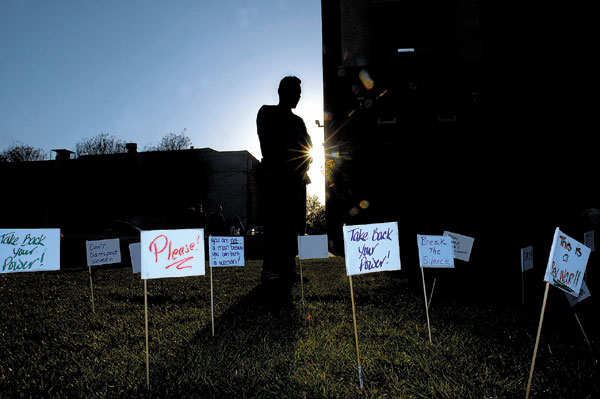Ana Torres was working the cash register at Target on Wednesday.
She said no shoppers were surprised by the added coinage tacked on
to their bill
– with the city’s 1 percent sales tax hike taking effect a day
earlier – but that she had noticed it right away.
Curtis Cartier – staff writer
cc******@***********ws.com
HOLLISTER
Ana Torres was working the cash register at Target on Wednesday. She said no shoppers were surprised by the added coinage tacked on to their bill – with the city’s 1 percent sales tax hike taking effect a day earlier – but that she had noticed it right away.
“I think it’s too much,” Torres said. “I was shopping on Tuesday and noticed as soon as I left the store.
“I think it might be worth it, though.”
Torres’ comments mirrored those of other shoppers in the store who said that while the added tax might be an inconvenience, it could be money well spent if streets get fixed, more police officers are on patrol and parks get cleaned up.
Everyone, however, wasn’t as understanding about the extra tax – it went from 7.25 percent to 8.25 percent – approved overwhelmingly by voters in November to boost city services that had declined after several rounds of budget cuts in recent years.
A couple visiting from Coalinga said it’s unfair to tax people during an economic crunch. The couple pulled out a half-dozen receipts from various towns and looked, with pained expressions, at the sales taxes – all of which were lower than 8.25 percent.
“It’s ridiculous to charge taxes on everything you buy,” said Ginger Coy, a state employee in Fresno County. “People can barely afford gas.”
The sales tax doesn’t quite encompass everything purchased – but almost. It’s applicable on all items with the exception of groceries, medical supplies, services, energy bills, farming equipment, public art purchases and certain nonprofit business purchases.
The increase effectively doubles the amount of tax funds Hollister can use. Since the state gets 6.25 percent of all sales taxes, it means the city will keep 2 percent instead of 1 percent of the money.
City Manager Clint Quilter said within two weeks he will present a proposal to city council members for approval that outlines how the extra money could be spent. He said the majority of the funds will go toward public safety, maintenance and parks and recreation.
City leaders had estimated that the increase would generate $3.5 million per year, though Quilter this week said because the economy has taken a downturn, that number could be smaller.
Officials are in the process of forming a citizens oversight committee comprised of voting residents chosen from a pool of people picked at random.
This panel is expected to keep track of how the money from the tax increase is spent by compiling biannual reports that track the funds. Quilter said letters to prospective committee members are being mailed and the group should be meeting within six weeks.
That group’s primary task will be oversight of the extra dollars that, for many these days, are harder to come by.
People like Manuel Galindo, a retired Hollister resident, who said that since he’s on a fixed income, he has to watch every penny he spends.
Still, the thought of newer and cleaner parks was a welcome idea, he said.
“Everywhere I go, it’s the same old parks, sometimes with trash everywhere,” Galindo said. “We’ll see if they actually do something with the money.”










